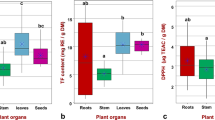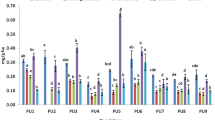Abstract
Lycium barbarum L. (abbreviated to L. barbarum) is a traditional medicinal and edible plant cultivated in different ecological areas in China. In this study, “Ningqi” No.1, one of the main cultivars of L. barbarum, was collected from 10 different important cultivation areas in 5 autonomous regions or provinces of China. Partial least squares regression and correlation analysis were used to analyze the relationship between 16 ecological factors, topographical, meteorological and soil factors and 9 phytochemicals of “Ningqi” No.1 fruits. There was no significant difference in carotenoids or ash in plants from the 5 regions or provinces (P ≥ 0.05), but total sugar content and total reducing sugars were lowest in Ningxia (P < 0.05), and total polysaccharides (3.61%), flavonoids (0.56%), and Se (0.62 mg/kg) were highest in Ningxia. Different chemical compounds were affected by different topographical, meteorological and soil factors. However, when taken as a whole, the most influential ecological factors were altitude, relative air humidity, accumulated temperature of ≥ 10 °C, annual mean air temperature, available potassium in soil, and annual precipitation. Except for the available potassium in soil, meteorological, and topographical factors had greatest effects on the accumulation of the main chemical compounds rather than soil factors.








Similar content being viewed by others
References
Amagase H, Famsworth NR (2011) NRA, review of botanical characteristics, phytochemistry clinical relevance in efficacy and safety of Lycium barbarum fruit (Goji). Food Res Int 44:1702–1717
Deng N, Chang E, Li MH, Ji J, Yao XM, Bartish IV, Liu JF, Ma J, Chen LZ, Shi SQ, Jiang ZP (2016) Transcriptome characterization of Gnetum parvifolium reveals candidate genes involved in important secondary metabolic pathways of flavonoids and stilbenoids. Front Plant Sci 7:174–180
Dong JZ, Yang JJ, Wang Y (2008) Resources of Lycium species and related research progress. China J Chin Mater Med 33:2020–2027
Fairweather-Tait SJ, Bao Y, Broadley MR, Collings R, Ford D, Hesketh JE, Hurst R (2011) Selenium in human health and disease. Antioxid Redox Sign 14:1337–1383
Ferrer-Gallego R, Hernández-Hierro JM, Rivas-Gonzalo JC, Escribano-Bailón MT (2012) Influence of climatic conditions on the phenolic composition of Vitis vinifera L. cv. Graciano Anal Chim Acta 732:73–77
Gao Y, Li XH, Zhang LY, Du LL (2011) Preliminary exploration of selenium rich area in Yinchuan basin. J Agric Sci 32:88–89
GB/T 19116–2003, Technical Regulations for Lycium barbarum Cultivation [S] (in Chinese)
Giuffrè AM, Zappia C, Capocasale M (2017) Physico-chemical Stability of Blood Orange Juice during Frozen Storage. Int J Food Prop 20(sup2):1930–1943
Giuffrè AM (2013) HPLC-DAD detection of changes in phenol content of red berry skins during grape ripening. Euro Food Res Technol 237:555–564
Gao YX, Li XH (2003) Ningxia wolfberry authentic sex research. Acta Geosci Sin 24:193–196
Gurbuz B, Bagdat RB, Uyanik M, Rezaeieh K, Afshar PR (2016) (Rosmarinus officinalis L.) cultivation studies under Ankara ecological conditions. Ind Crop Prod 88:12–16
Hempel J, Schädle CN, Sprenger J, Heller A, Carle R, Schweiggert RM (2017) Ultrastructural deposition forms and bioaccessibility of carotenoids and carotenoid esters from goji berries (Lycium barbarum L.). Food Chem 218:525–533
Huang LF, Li WT, Wang Z, Fu J, Chen SL (2013) Correlation of chemical composition and ecological factors in endangered plateau plant Notopterygium root. Acta Ecol Sin 33:7667–7678
Kaur T, Bhat R, Vyas D (2016) Effect of contrasting climates on antioxidant and bioactive constituents in five medicinal herbs in Western Himalayas. J MT Sci 13:484–492
Kumar K, Gupta S, Arya M, Nasim M (2016) Growth and physiochemical responses of Camelina sativa L. under UV-C stress. Acta Physiol Plant 38:1–9
Lam SC, Luo Z, Wu DT, Cheong KL, Hu DJ, Xia ZM, Zhao J, Li SP (2016) Comparison and characterization of compounds with antioxidant activity in Lycium barbarum using high-performance thin layer chromatography coupled with DPPH bioautography and tandem mass spectrometry. J Food Sci 81:1378–1384
Li JP, Zhang XY, Liu J (2004) Relationships between appearance quality and meteorological conditions of Chinese wolfberry. Meteorol Mon 30:51–54
Li SZ (2018) Compendium of Materia Medica. Tianjin Sci & Technol Press, Tianjin, pp 2750–2756
Liu J, Zhang XY, Yang YL, Ma LW, Zhang XY, Ye DX (2004) Study on the relationship between Chinese wolfberry and meteorological conditions. Agric Meteorol 25:17–21
Magiera S, Zaręba M (2015) Chromatographic determination of phenolic acids and flavonoids in Lycium barbarum L. and evaluation of antioxidant activity. Food Anal Method 8:2665–2674
Silvanini A, Dall AC, Morrone L, Cirlini M, Beghè D, Fabbri A, Ganino T (2014) Altitude effects on fruit morphology and flour composition of two chestnut cultivars. Acta Oecol 9:311–318
Tang HL, Chen C, Wang SK, Sun GJ (2015) Biochemical analysis and hypoglycemic activity of a polysaccharide isolated from the fruit of Lycium barbarum L. Int J Biol Macromol 77:235–242
Vulić JJ, Čanadanović-Brunet JM, Ćetković GS, Djilas SM, Tumbas Šaponjac VT, Stajčić SS (2016) Bioactive compounds and antioxidant properties of Goji fruits (Lycium barbarum L.) Cultivated in Serbia. J Am Coll Nutr 35:692–698
Wang SY, Zheng W (2001) Effect of plant growth temperature on antioxidant capacity in strawberry. J Agr Food Chem 49:4977–4982
Wang ZY (2003) Study on active component from the fruit of Lycium barbarum in different regions. Bull Botan Res 23:337–339
Wu ZH, Li WL, Zhao LJ, Shi JF, Liu Q (2015) Drying characteristics and product quality of Lycium barbarum under stages-varying temperatures drying process. Trans Chin Soc Agric Eng 31:287–293
Xie JH, Tang W, Jin ML, Li JE, Xie MY (2016) Review: Recent advances in bioactive polysaccharides from Lycium barbarum L., Zizyphus jujuba Mill, Plantago spp., and Morus spp: Structures and functionalities. Food Hydrocolloid 60:148–160
Panuccio MR, Papalia T, Attinà E, Giuffrè AM, Muscolo A (2019a) Use of digestate as an alternative to mineral fertilizer: effects on growth and crop quality. Arch Agron Soil Sci 65:700–711
Panuccio MR, Papalia T, Attinà E, Giuffrè AM, Muscolo A (2019) Use of digestate as an alternative to mineral fertilizer: effects on growth and crop quality. Arch Agron Soil Sci 1–12
Yang QZ, Wang ZH, Fu J, Liu DW, Huang LF (2015) Astragalus membranaceus chemical composition and the correlation of ecological factors. Chin J Appl Ecol 26:732–738
Yang ST (2011) Studies on phytochemical diversity of Scrophularia ninspoensis Hemls. and its association with genetic and environmental variation, Zhejiang Univ, Hangzhou, China
Yang XY, Liu YL, Hou AJ, Yang Y, Tian X, He LY (2017) Systematic review for geo-authentic Lonicerae Japonicae Flos. Front Med 11:203–221
Yu SJ, Qian L (2016) Protective effect of polysaccharides from Lycium barbarum on spermatogenesis of mice with impaired reproduction system induced by cyclophosphamide. Am J Reprod Immunol 76:383–385
Zeng FL, Wang H, Wen MJ, Zhang XCX (2015) Relationships between effective constituents of Lycium barbarum L. and climatic factors. Chin Tradit Pat Med 37:2696–2701
Zhang QY, Chen WW, Zhao JJ, Xi WP (2016) Functional constituents and antioxidant activities of eight Chinese native goji genotypes. Food Chem 200:230–236
Zhang XY, Liu J, Yuan HY, Zhang XY (2003) LBP and quantitative relationship of soil nutrient and meteorological conditions. Agric Res Arid Areas 21:43–46
Zhang XY, Liu J, Wang LX (2004) Build the evaluation system of Ningxia wolfberry quality comprehensively. Sci Agric Sin 37:416–421
Zhao R, Hao WL, Ma BL, Chen ZB (2015) Improvement effect of Lycium barbarum polysaccharide on sub-health mice. Iran J B Med Sci 18:1245–1252
Zheng GQ, Zheng ZY, Xu X, Hu ZH (2010) Variation in fruit sugar composition of Lycium barbarum L. and Lycium Chinense Mill. of different regions and varieties. Biochem Syst Ecol 38:275–284
Zhu YF, Zhao QP, Gao H, Peng XD, Wen YM, Dai GD (2016) Lycium barbarum polysaccharides attenuates N-methy-N-nitrosourea-induced photoreceptor cell apoptosis in rats through regulation of poly (ADP-ribose) polymerase and caspase expression. J Ethnopharmacol 191:125–134
Acknowledgements
This work was supported by Grants-in-Aid for scientific research from the National Natural Science Foundation of China (31360076), Key projects of Ningxia (2020ZDYF0852) and Pilot project by Ningxia Academy of Agriculture and Forestry Science (NKYJ-15-16, NKYZ-16-05).
Author information
Authors and Affiliations
Corresponding authors
Ethics declarations
Conflict of interest
The authors declare that they have no competing interests.
Additional information
Communicated by P. Wojtaszek.
Publisher's Note
Springer Nature remains neutral with regard to jurisdictional claims in published maps and institutional affiliations.
Rights and permissions
About this article
Cite this article
Mi, J., Yan, Y., Li, Y. et al. The effects of ecological factors on the chemical compounds in Lycium barbarum L.. Acta Physiol Plant 42, 84 (2020). https://doi.org/10.1007/s11738-020-03069-1
Received:
Revised:
Accepted:
Published:
DOI: https://doi.org/10.1007/s11738-020-03069-1




